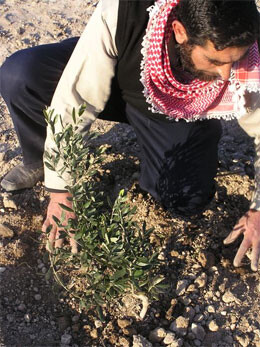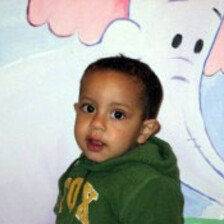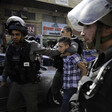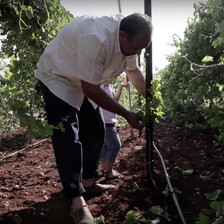Arab Association for Human Rights (HRA) 14 February 2008

Ramzi Shahadeh
In Middle Eastern culture the olive tree has become the main symbol of stability, tranquility and peace. The olive tree also symbolizes the eternal bond between humans and the land. On 13 November 1974, when Yasser Arafat spoke at the UN Assembly in New York for the first time as the representative of the Palestinian people, he famously commented: “Today I have come bearing an olive branch and a freedom fighter’s gun. Do not let the olive branch fall from my hand.”
Palestine has always been closely associated with the olive tree. The native Palestinians admired the olive for its splendid appearance, with its fresh green leaves and powerful roots that can penetrate rocks, and for the diverse properties of olives and olive oil. Olives are used as a staple food item, while olive oil is used for lighting, moisturizing the skin, curing various ailments and wounds, and strengthening the skin and muscles. Olives were also used to manufacture ink and soap. The olive tree has a remarkable capacity to bear fruit over hundreds and even thousands of years. In the Galilee and Jerusalem there are some olive trees that are over two thousand years old and which still bear fruit.
The unique qualities of the olive tree made it an emblem of the Palestinian people’s struggle against the Israeli occupier, a symbol of sumoud (steadfastness) in the face of draconian occupation, and a metaphor for the people’s deep roots in the land — roots that cannot be torn up by any external power. In the occupied territories many cases have been seen in which olive trees have been uprooted by bulldozers on the pretext of “security,” in order to expand settlements or build the “separation barrier” — and always at the expense of Palestinian land. For Palestinians, the uprooting of olive trees symbolizes the effort by Israel to tear up the Palestinian people’s deep roots in the land. Such acts carry an implicit message from the Israeli side: “You have no roots here and no rights to this land.” Uprooting olive trees also symbolizes the trampling by Israel of any chance for peace and calm in this small piece of land.
The incident detailed in this report offers a powerful illustration of Israel’s attitude toward the Arab citizens in terms of the usurping of land and the uprooting of olive trees.
On 14 June 2007, bulldozers from the Ministry of the Interior and the Israel Lands Administration uprooted dozens of olive trees belonging to the residents of the Arab village of al-Mashhad in the Galilee, claiming that the land had been confiscated in favor of the Jewish city of Nazareth Illit (Upper Nazareth). Several members of the Shahadeh family (one of the landowning families in the village) were arrested when they attempted to enter their land after the police had surrounded the area. The uprooted trees were left in the orchard, and the next day the landowners and some of the residents of al-Mashhad replanted the uprooted trees, along with new saplings. Since this incident the residents have established a protest tent on the site, with a permanent presence at all times. Khalid Kraim, a member of the Popular Committee Against the Confiscation of the Lands of al-Mashhad, comes from a family that owns one of the plots of land earmarked for confiscation. Kraim explains, “We established the protest tent to prove to all of those who are planning to usurp our land that the owners will not let this happen again. With the help of our relatives and some of the residents of the village we defended our land, taking turns guarding around the clock. We want to prevent any attempt by the authorities to come here again and damage the area.”
On 15 January 2008, approximately six months after the first incident, the residents left the protest tent, assuming that time had passed and the issue had been forgotten. The very same day, in a carefully planned operation, a large police force arrived, accompanied by bulldozers, and uprooted over 400 olive trees.
The land in question covers an area of approximately 16 acres. According to the Nazareth Illit Municipality, it was confiscated in 1976, but the confiscation was never executed. In 1996, Israeli Interior Minister Chaim Ramon decided to nullify part of the confiscation order. Two years ago a hearing on the issue took place in the high court. The original landowners argued that the confiscation order had become obsolete after remaining unexecuted for such a long period. The court decided that the land would not be returned to its owners, but should be left as a green area, as stated in the confiscation orders and the outline plan for the district. The court added that the owners should be permitted to work the land and to enter the area during the olive harvest.
The Nazareth Illit Municipality is basing its position on steps taken in 1976 when the campaign began to confiscate tens of thousands of acres of Arab-owned land in the Galilee. Since then, thousands of acres of land in the Galilee have been confiscated from the residents of the Arab communities of Ein Ma’ahal, al-Mashhad, Kafr Kanna, Raineh, and Nazareth. The land has been confiscated on the basis of the decision of the Israeli finance minister, applying emergency legislation that empowers the minister to confiscate land for the general good. Commenting on the attitude of the state toward the Arab citizens, Khalid Kraim notes: “We are totally convinced that Israel was established on the lands of our people, which was expelled from its land. This is an accomplished fact. Why should I, as a citizen, have to feel as if I am only a citizen on a short-term basis? No Arab living in the state of Israel can know what to expect in the future.”
The campaign to “judaize” the Galilee
The land confiscations were accompanied by the preparation of the so-called “Koenig Document,” authored by Israel Koenig, who served for 26 years as the director of the Northern District in the Israeli Ministry of the Interior. Published by the newspaper al-Hamishmar in 1976, the document included a plan to usurp and confiscate Arab land and to alter the demographic balance in the Galilee with the goal of “judaizing” the area. The plan also discussed other aspects, such as encouraging Arabs to emigrate; strengthening the obstacles limiting admissions to university among Arabs; and creating an Arab political party that would function as an arm of the government among this population. It is interesting to note that in an interview with the Israeli daily Haaretz a few years ago, Koenig stated that a friend of his, “a rich Christian from Nazareth,” still thanks him for convincing him to emigrate to Canada many years ago. Koenig convinced his friend to leave by telling him that “things will never be good here for your children.”
At the beginning of 1976, encouraged by this document, the Israeli government began a new campaign to usurp land from Arab citizens on an enormous scale, particularly in the Galilee, as part of the plan to judaize the area. The confiscation plan in the Galilee covered a total of some 5,000 acres of land, and created profound anger among the Arab population. Prior to the announcement of the confiscation plan many Arab citizens had deluded themselves into believing that after successive Israeli governments had already confiscated most of the land belonging to the Arab population between 1948 and the late 1960s, no further blows would be imposed. The Galilee Development Plan published in October 1975 by the Ministry of Agriculture made no attempt to hide the national objective of the “development” it envisaged: “A particular problem in the Galilee is that the Jewish population constitutes a minority compared to the non-Jewish population. In 1973 there were 147,000 non-Jews and 62,000 Jews … The current situation in terms of the demographic balance between the Jewish and non-Jewish population must be changed by means of a long-term program …”
In 1976, action began to implement the plan. Over the year some 5,250 acres of land belonging to the Arab population were confiscated in favor of the state of Israel.
The National Committee for the Protection of Arab Land decided to call a general strike for 30 March 1976 and to organize demonstrations against the usurping of land. The largest demonstrations took place in Sakhnin, Arabeh, and Dir Hanna. The protests began peacefully but soon descended into violence after the police opened fire with live ammunition. After the Israel police realized that it could not control the demonstrations it turned to the army, which killed four demonstrators (two more demonstrators were killed by the police). Three of the victims came from Sakhnin. These events came to be known as Land Day, and on 30 March 30 each year the Arab population marks Land Day with strikes, demonstrations, and processions in memory of these events.
A large proportion of the Arab-owned land in the vicinity of Nazareth Illit was confiscated over the years. This land now forms part of the Jewish city of Nazareth Illit. The Arab citizens were told that the grounds for the confiscation orders were security reasons. Khalid Kraim comments, “The Israel Lands Administration claims that the confiscation implemented in 1976 was for security reasons. It is true that an IDF base was established in the area during this period, but this was probably just a propaganda move to justify the security grounds for confiscation, since just one year later the [Israeli army] vacated the base.”
Although 30 years passed since the confiscation decision of 1976, some of the land was never actually confiscated. The landowners continued to hold and use the land. Nazareth Illit had no need for these reserves of land at the time — a fact that proves the absence of any real need for the confiscation. Now, however, the Israeli authorities are attempting to implement the decision in order to continue to expand the Jewish neighborhoods in the area, and particularly the Har Yonah neighborhood of Nazareth Illit, at the expense of land seized from the village of al-Mashhad. The decision ignores the fact that these areas form part of the land reserve of the Arab population in the region. The land is privately owned by Arab citizens, and has been seized in order to build new neighborhoods to house Jewish immigrants, mainly from the former Soviet Union. Khalid sadly comments, “Why is a resident of al-Mashhad forbidden to stand on his land, to farm it and to care for his trees, while someone who just arrived from Russia goes out jogging in the morning with his dog on our land?”
Jew or non-Jew, that is the question
When David Ben Gurion was asked about the possibility that Palestinian refugees might return to their homeland in Palestine, he replied: “This land belongs to two people — to the Arabs who live in it, and to Jews all over the world.” This statement by the first prime minister of Israel and the key architect of the Zionist ideology in the state of Israel is still highly relevant. The political and social approach of all the Israeli governments over the past 60 years argues that the Palestinians who remained on their land in 1948 are to become Israeli citizens and receive Israeli identity cards, while emphasizing that not a single refugee will be permitted to the land seized in the same year. At the same time, Israel welcomes all the Jews of the world with open arms, providing ongoing personal assistance during their first years in the country.
Jewish immigrants receive grants to facilitate their initial absorption in “Zion,” mainly in the form of an “absorption basket,” customs discounts, support from the Jewish Agency for Israel in arranging migration and payment of the flight ticket to Israel. One of the main areas of help is assistance in housing, implemented through public housing and a system of mortgages, loans, and rent aid. As each wave of Jewish immigrants has arrived, new neighborhoods and communities have been built throughout the country. In central Israel, the Negev, and the Galilee neighborhoods and communities have been built on land that was formerly owned by Arabs.
The early 1990s was the peak period in terms of the construction of new neighborhoods. This period saw the largest wave of Jewish immigration in the past forty years (636,805 immigrants arrived, constituting 53 percent of all immigrants during the period 1989-2005).
The Har Yonah neighborhood of Nazareth Illit is an example of a neighborhood built specifically to house new immigrants arriving in Israel. Construction work began in the early 1990s, and the neighborhood now has a population of 10,000, including veteran Israeli Jews, Jewish immigrants (approximately 70 percent), and a small number of Arabs. The neighborhood is situated on the ridge of Mt. Yonah, between the Arab communities of Ein Ma’ahal, Raineh, al-Mashhad, and Kafr Kanna — the communities affected by the confiscation campaign of 1976.
The Arab village of al-Mashhad, with a population of 6,900, is situated next to the new neighborhood. Most of the villagers have low socioeconomic status (in 2005, the average income of salaried employees in the village was NIS 3,563, compared to the national average of NIS 7,324). Due to the miserable reality imposed on the village by the state, al-Mashhad is effectively under siege, surrounded on all sides, without any prospects for development. The village is bordered to the south by Road No. 79, the highway from Nazareth Illit to Haifa. To the west the village borders on Moshav Zippori, a Jewish community established on the land of the villages of Jabl al-Kharub and Safuriya, which were destroyed during the Nakba of 1948 (part of Zippori was built on land belonging to al-Mashhad). Zipporit Industrial Zone also lies to the west of al-Mashhad. Although the industrial zone is separated from Nazareth Illit (some seven kilometers away) by the Arab village, it forms part of the area of jurisdiction of Nazareth Illit. To the north the village borders on the Arab village of Kafr Kanna, and to the east on the neighborhood of Har Yonah, which forms part of Nazareth Illit.
Prior to the confiscation orders, the village of al-Mashhad included a total of 2,767 acres of land. This has now been reduced to some 1,825 acres, of which just 207.5 acres are earmarked for construction. Khalid Kraim stands on his land, pointing at the village: “There is a serious housing problem in the village. Many people leave the village because their land has been taken, or because they cannot obtain building permits. Even some of the landowners here from the Shahadeh family live in the [neighboring] village of Raineh because they cannot get permits to build on their land.”

Mahmud Shahadeh
Ramzi Shahadeh, another landowner in the village, compares his own situation with that of the new immigrants living in the adjacent neighborhood of Har Yonah: “I wished we had the same life as they do in Nazareth Illit in terms of the services they receive — roads, cleaning, and parks for their children. Even the idea of comparing al-Mashhad and Nazareth Illit is a joke. For example, if I want to take my children to play then we go to the parks in Nazareth Illit, because in al-Mashhad there isn’t a single acre of land zoned for parks.” Shahadeh continues: “I feel as if I were living in South Africa, while alongside me is a European or American city. What’s even more annoying is that for 25 years we have been trying to get permits to build on land that belongs to us, while a new immigrant who arrives from Russia or Europe gets a home and space to live in a few hours after getting off the plane.”
“What happened in 1976 won’t be repeated”
The olive tree is one of the most common trees in Palestine. The reason for this is that the tree forms a key part of Palestinian folklore. Almost every Palestinian family that owns some land begins by planting olive trees. The tree also symbolizes the culture of the Palestinians and forms part of their history and their bond with the land and with nature. Over time, the olive tree also came to play a central part in the Palestinian economy.
The olive trees on the lands of al-Mashhad serve three large families (a total of some 350 residents), most of whom are peasants (fallahin) whose main, and often sole, occupation is caring for the land. Last year, the Shahadeh family managed to produce almost 70 tin cans of olive oil from a two-acre plot; this plot accounts for about one-third of the total area belonging to the family in which olive trees were uprooted.
Mahmud Shahadeh comments: “I’ve tended to the olive trees for 30 years, making a living for my family. In just two hours, the police destroyed all that I have worked for.” Khaled, Mahmud’s son-in-law, continues: “We come from a family of fallahin that makes its living from the land. One tin can of olive oil costs about NIS 700 this year, so a simple calculation shows that we lost almost NIS 49,000 (approximately US 13,500), not to mention that fact that the three families also use olives and olive oil for their own personal consumption.” Khalid emphasizes that this constitutes the family’s main source of income: “I never heard my father or grandfather mention buying olives or olive oil from anyone else. It scares me to think that we might have to use olive oil we bought from elsewhere.”
“We are law-abiding citizens and all we want is to live on our own land like human beings. Yet Israel treats us like second-class citizens or criminals,” Khalid says. “It reminds us all of words like ‘transfer.’ Every day we hear of Muslim or Christian cemeteries being demolished in the Palestinian villages from 1948. What we are demanding is the liberty and democracy we are entitled to as citizens. If citizens in Israel have rights, then they must also be granted to the Arab population.” Khalid speaks openly, expressing his belief that all the Arabs in Israel feel that the state says one thing while doing something completely different: “Israel puts on a fine white dress, but underneath is a black morass of racism and discrimination.”
Ramzi seeks to send a message of determination and anger through the Arab Association for Human Rights: “On behalf of the landowners, the Shahadeh family, and the residents of the village of al-Mashhad, I want to send a message to people everywhere — the Jewish National Fund, to the Nazareth Illit Municipality, to the Members of Knesset and the government, and to the residents of Israel. We don’t want the events of 1976 to repeat themselves, but I have to say that not one meter of land will be taken from us unless we die on our lands. We do not hold any hatred or racist feelings toward anyone. We just want to resolve the matter in a just way. If not, there will be no turning back. We don’t have anywhere else to live or to build our homes. We are a family that makes its living from agriculture and we have no other land to farm. Either we will die or we will live in peace with the neighboring cities without our lands being harmed. I repeat: what happened in 1976 won’t be repeated,” Ramzi emphasizes.
This story emphasizes once again the way in which Israel tramples on everything that this region and place symbolize for the Palestinian residents, the indigenous inhabitants of the land. Uprooting olive trees in an Arab village and the goals and motives that lie behind such actions constitute a deviation from nature, changing the natural landscape of the village and the surrounding area. Israel attempts to alter the natural indigenous character of the land in order to build European-style residential areas, in a setting in which these do not belong. In order to create this alternative environment, Israel must uproot the olive tree — the central emblem of Palestine and the symbol of peace. This reality underscores the heavy price paid by the indigenous inhabitants of the land for the establishment of a Jewish state in “Zion.”
This report is the second in a series of Discrimination Diaries by the Arab Association for Human Rights (HRA), shedding light on the rights situation of Palestinians in Israel. All images by HRA.
Related Links



